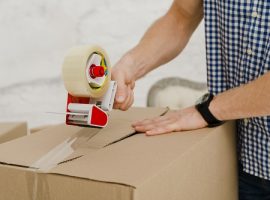Decluttering brings about many benefits that will increase your quality of life. But if you’re about to move house, it takes on a whole new level of importance, helping to lower the chaos of moving.
Estimated reading time: 9 minutes
This Article Will Cover:
When it comes down to it, we all have a few odds and ends lying around the house – and most of us may have more than a little. Household clutter seems relatively harmless. But many of us can feel stressed when surrounded by more things than we can manage. That is why it is so important to declutter at the right times.
Here at Getamover, we have put together some of our fool-proof methods to help you on your decluttering journey. These methods are aimed at helping you declutter your house before you move to ensure the packing process is seamless. To learn more about how decluttering will help you save money and time when moving, read on.
Need help with decluttering?
Find the perfect moving firm to assist.
Why Do You Need to Declutter Before Moving Home?
You might not be surprised to learn that decluttering can be a highly beneficial exercise for your mental health. By achieving an organised home, you signal an ordered mind and life. A clutter-free home doesn’t just look good; it can help you relax. When you declutter before you move, you’re starting from the basics, clearing out everything you don’t want or need, and then moving forward.
Above and beyond getting rid of items you don’t want or need anymore, decluttering before your move helps you save money on removal costs (as the removal company will be moving across fewer items). If you have received your removal quote before decluttering, make sure to inform the removal company as the quote may need to be adjusted.
What Methods Can You Use to Declutter?
1. KonMari
This method was first introduced by Marie Kondo, who wrote The Life-Changing Magic Of Tidying Up, and has become one of the most well-known decluttering methods out there today. The core principle behind KonMari is not deciding which items you are going to throw out but instead deciding on which ones to keep and then decluttering the rest.
To get started with this method, go through each item one by one to get a good sense of how it may make you feel. Then, you need to ask yourself “Does this (item) spark joy?” If your answer to this question is no, then you need to treat that specific item with respect and send it off to a new life.
2. Four-Box-Method
The Four-Box-Method is an adaptable way for you to deal with various items that may be cluttering up your home. By categorizing the clutter into four groups, you’ll be able to decide which items belong where. To get started, place four boxes in a room and label each box:
- Put away
- Throw away
- Donate
- Undecided
Begin picking up various items in the room and place them into one of the boxes. Make your way through the house until you feel you are finished. Once completed, process each box according to the description of the box.
3. The 90/90 Minimalism Rule
Something we can all relate to is that whenever there is an attempt to simplify aspects of our lives, more often than not we get stuck before we even begin. When you are faced with a variety of possessions, it can become difficult to accurately determine what value each piece adds, and what we may be holding onto for a “just-in-case” moment. This can make letting go and getting rid of items almost impossible.
The Minimalists, also known as Joshua Fields Millburn and Ryan Nicodemus, put forward the 90/90 rule for you to face the task of decluttering head-on. The rule works as follows: Look around your home and pick out an item. It can be anything. Ask yourself this: “Have I used this item in the last 90 days?” If you haven’t within the last few days, ask yourself this follow-up question: “Will I use the item in the next 90 days?” If you won’t, then it is time to let it go.
The nice thing about this rule is that it is malleable to you. Maybe, your rule is not 90 days. It could be 120 days, six months or a year. Whatever timeframe suits you, becomes your rule. But remember to be honest with yourself. If there is a material possession that doesn’t serve a purpose or bring joy to your life, then that possession is more than likely in the way of a more meaningful life.
Where Do You Begin to Declutter?
You have now decided it is time to declutter and which method you would like to use but now you are left with the question: “Where do I begin?” Of course, this depends on you as a person – but here are four rooms you can start with on your decluttering journey.

Living/Family Room
The ultimate purpose of this room is to provide space for relaxation. If this room is cluttered with various items, it will most definitely make it harder for anyone to unwind. Time to give your family room a bit of a refresh!
“Un-Decorate” the Space
Now we know this term sounds weird but sometimes you may just have too many items sitting around your living room, making the space feel cluttered. Here are some tips to “Un-Decorate”:
- Limit the number of throw pillows and blankets you have
- Sort through collectables and decor items that may be crowding the space
- Create statement pieces with the items you want to keep
Decide on Items That Belong
Most of the time, various items from around the house make their way into the space. We recommend starting with these items. This could be your kids’ toys, the mail, kitchenware, or magazines – it unintentionally hogs up beloved space and is not where they rightfully belong.
You may also find that you have a variety of entertainment items you haven’t used in a while. This could be DVDs, old remote controls, CDs, books, and cables. Sort through these items and decide whether it is a staple to your living room space. If is not, donate or sell these items or convert what you can into a digital format. This will help you open up the space while parting with an item that has lost its usefulness.

Bathroom/s
When it comes to decluttering the bathroom, it is quite straightforward. Once you begin, you may be surprised by the various items you have and the amounts of each as you sort through it all.
Pull Everything Out
Pull out all the various items that are taking up space on your bathroom showers/tubs, counters, shelves, and inside cabinets.
Group Similar Items Together
When you have successfully pulled all of the items out, it is time to group items that are alike (even if they came from other bathrooms). We recommend making piles for certain things like:
- Toiletries
- Towels
- Medicine
- Cleaning Supplies
- Makeup
When you have successfully created these piles, it will assist you in taking inventory of what you currently have and what may play a factor in cluttering up your space. You could have item duplicates, expired products, or things you just don’t use or like anymore. With the identification of these different items, you can decide what you are keeping and what you can get rid of.
Create Organisation Systems
You have now pulled everything out and grouped items, which makes it easier to determine what unnecessary items you may want to get rid of. It is time to make sure you keep all your newly sorted items organised. Make use of boxes, baskets and dividers (new & repurposed) to use as organisers.

Bedroom
Most of the time, your bedroom can become a central dumping ground for various items that may not have a purpose in another room. The number of items you have in your bedroom determines the amount of time you will spend clearing out and organising your bedroom.
Start with your Drawers & Cupboards
You will be surprised by what you may have hidden in your cupboards and drawers. We recommend taking everything out of your drawers. Once that is complete pick up an item and ask yourself the following questions:
- Does this item belong in your bedroom?
- Have you worn or used this item recently? (You can determine your timeframe here: e.g. within the last year, the last 6 months or the last week. Remember to choose any timeframe that works best for you).
If your answer to either one of those questions were “no”, decide if there is a room that it belongs to and if you will make use of there. If not, decide whether you are donating or getting rid of the item. Once you have sorted through all of the items, it is time to place them back into their respective places.
Keep Open Surfaces Organised
Try to keep any open surfaces in your room as clear as you can. This could be on your bedside table, a dresser, a shelf or a windowsill. Try to limit the open surface to 3-5 items that make your bedroom feel like you. When fewer items are sitting on open surfaces, a space will feel more peaceful.

Kitchen
The kitchen can be one of the most used rooms in the house, even if you do not cook regularly. There are a lot of items in this space: crockery, cutlery, appliances, food items, beverages, cookware and many others. These items are constantly competing for a spot in the kitchen! This makes it easy for clutter to build up on the countertops or in the drawers and cabinets. We recommend doing the following:
Highlight essential items in your day-to-day routine
This is specific to you as you know what you use daily. We recommend choosing 3-5 essential items. This could be a kettle, toaster, knife block, microwave, or coffee machine. Now that you know what your essential items are, rate your non-essential items from most used to least used. This gives you a clearer breakdown of what you see as the most important in your kitchen.
Clear the non-essential items
Now that you have decided on your non-essential items, it is time to figure out if you will still have a use for this item. If this item was used long ago, infrequently, expired or has many duplicates, consider donating or throwing these items away.
Group your items
Once you have decided what to part with, it is time to sort through what you are keeping. You now time to group items that are alike. We recommend grouping the following:
- Baking Supplies
- Pots, Pans & Dishes
- Cutlery
- Crockery



